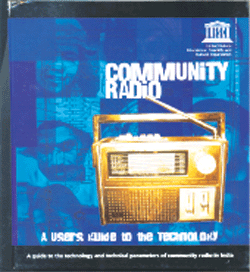Community Radio: A User’s guide to the Technology
Author: N. Ramakrisnan
ISBN: 81-89218-12-3
Publisher: UNESCO
Year of Publication: 2007
Pages: 276
 Community Radio Stations (CRS) unlike the commercial ones are mainly into transmission of news, updates and initiatives to a particular segment of the community. It is a tool not only to empower and capacitate underprivileged sections but also to facilitate better forms of learning and interaction among the local people. Initiation of CRS can also be identified as an endeavour to decentralise radio frequencies. Implementation of community radio programmes have been furthered by the exclusive plan of the Govt of India to establish 4000 CRS in different rural localities across the country. In the wake of rural participatory development programmes and community development initiatives, community radio is playing a major role in disseminating vital information on rural community living, primary education, rural projects and community health.
Community Radio Stations (CRS) unlike the commercial ones are mainly into transmission of news, updates and initiatives to a particular segment of the community. It is a tool not only to empower and capacitate underprivileged sections but also to facilitate better forms of learning and interaction among the local people. Initiation of CRS can also be identified as an endeavour to decentralise radio frequencies. Implementation of community radio programmes have been furthered by the exclusive plan of the Govt of India to establish 4000 CRS in different rural localities across the country. In the wake of rural participatory development programmes and community development initiatives, community radio is playing a major role in disseminating vital information on rural community living, primary education, rural projects and community health.

With the advent of community radio programmes in India, several queries on the use, applicability and functional effectiveness of community radio have emerged among the pool of community radio users, operators and technicians. The book under review provides for a fair explanation of the technologies and technology-enabled services required to operationalise CRS. The book is written lucidly in order to make the readers understand the technical nuances of mass broadcasting, public telecast and development reorganisation in rural societies in India. While writing the book, the author has taken into cognisance UNESCO’s programme focusing on community access and engagement. The book also furnishes information on CR related terms and regulations and the licensing procedures required to be met in order to open a CRS.
The book in the form of a manual is a sincere attempt to integrate and differentiate between the instrumental efficacy of broadcasting machineries, techniques and mechanisms required to execute and implement community radio programmes throughout India. The manual is a narrative description of the logistics that are used in CRS and the technologies that are employed in the application of community radio programmes in different parts of rural India. The book is a boon for technicians, users and operators of community radio.

The book embodies a very formal introduction of those people who should be using the manual for gaining hands-on knowledge and expertise in community radio broadcasting mechanisms. The manual sets the guidelines for its users who are interested in setting up CRS. The manual also delineates the types of equipment that a CRS require and the components of radio production and broadcast process.
Chapter 1 of the book gives an overview of community radio and the radio broadcasting processes. To ensure better forms of radio broadcasting, the author suggests five processes viz. research and pre-production, production, post-production, transmission/broadcast and feedback. In chapter 2, we find the guidelines that are to be followed while establishing a CR station. The chapter also speaks about three types of studio spaces in the form of broadcasting studio, production studio and office space. Chapter 3 speaks about the technologies and studio equipment required for broadcasting studio, production studio and office space. The 4th chapter goes on to argue why do we need field recording equipment, what should a field recording system consist of and what are the main considerations in selecting field recording equipment. The 5th and 6th chapters give a vivid explanation of the transmission and telecommunication devices that are required to foster community radio broadcasting. The seventh chapter of the book underscores some safety regulations that are required to maintain a steady functioning of CR stations. The last two chapters are all about training and procedural requirements that are to be met while opening and validating a CR station. The book also consists of an all-encompassing appendices section that not only contains a list of technical tools for CR stations, but also lists the audio and radio equipment manufacturers available across the globe.
The book has some merit in the sense that it serves technical guidance and supervision to people who are wishing to install and use community radio and related community broadcasting programmes. This apart, the book is informative and contains a list of itemised tools and the names and contact addresses of individuals, organizations and vendors. The book has some lacunae as well. The book is devoid of a formal conclusion. Moreover, the book fails to provide a substantial judgment on the reasons to switch over to a community radio mode.
Be a part of Elets Collaborative Initiatives. Join Us for Upcoming Events and explore business opportunities. Like us on Facebook , connect with us on LinkedIn and follow us on Twitter, Instagram.











